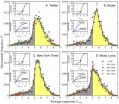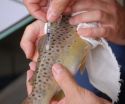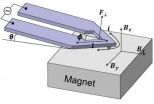(Press-News.org) WEST LAFAYETTE, Ind. - Honeybee populations have been in serious decline for years, and Purdue University scientists may have identified one of the factors that cause bee deaths around agricultural fields.
Analyses of bees found dead in and around hives from several apiaries over two years in Indiana showed the presence of neonicotinoid insecticides, which are commonly used to coat corn and soybean seeds before planting. The research showed that those insecticides were present at high concentrations in waste talc that is exhausted from farm machinery during planting.
The insecticides clothianidin and thiamethoxam were also consistently found at low levels in soil - up to two years after treated seed was planted - on nearby dandelion flowers and in corn pollen gathered by the bees, according to the findings released in the journal PLoS One this month.
"We know that these insecticides are highly toxic to bees; we found them in each sample of dead and dying bees," said Christian Krupke, associate professor of entomology and a co-author of the findings.
The United States is losing about one-third of its honeybee hives each year, according to Greg Hunt, a Purdue professor of behavioral genetics, honeybee specialist and co-author of the findings. Hunt said no one factor is to blame, though scientists believe that others such as mites and insecticides are all working against the bees, which are important for pollinating food crops and wild plants.
"It╒s like death by a thousand cuts for these bees," Hunt said.
Krupke and Hunt received reports that bee deaths in 2010 and 2011 were occurring at planting time in hives near agricultural fields. Toxicological screenings performed by Brian Eitzer, a co-author of the study from the Connecticut Agricultural Experiment Station, for an array of pesticides showed that the neonicotinoids used to treat corn and soybean seed were present in each sample of affected bees. Krupke said other bees at those hives exhibited tremors, uncoordinated movement and convulsions, all signs of insecticide poisoning.
Seeds of most annual crops are coated in neonicotinoid insecticides for protection after planting. All corn seed and about half of all soybean seed is treated. The coatings are sticky, and in order to keep seeds flowing freely in the vacuum systems used in planters, they are mixed with talc. Excess talc used in the process is released during planting and routine planter cleaning procedures.
"Given the rates of corn planting and talc usage, we are blowing large amounts of contaminated talc into the environment. The dust is quite light and appears to be quite mobile," Krupke said.
Krupke said the corn pollen that bees were bringing back to hives later in the year tested positive for neonicotinoids at levels roughly below 100 parts per billion.
"That's enough to kill bees if sufficient amounts are consumed, but it is not acutely toxic," he said.
On the other hand, the exhausted talc showed extremely high levels of the insecticides - up to about 700,000 times the lethal contact dose for a bee.
"Whatever was on the seed was being exhausted into the environment," Krupke said. "This material is so concentrated that even small amounts landing on flowering plants around a field can kill foragers or be transported to the hive in contaminated pollen. This might be why we found these insecticides in pollen that the bees had collected and brought back to their hives."
Krupke suggested that efforts could be made to limit or eliminate talc emissions during planting.
"That's the first target for corrective action," he said. "It stands out as being an enormous source of potential environmental contamination, not just for honeybees, but for any insects living in or near these fields. The fact that these compounds can persist for months or years means that plants growing in these soils can take up these compounds in leaf tissue or pollen."
Although corn and soybean production does not require insect pollinators, that is not the case for most plants that provide food. Krupke said protecting bees benefits agriculture since most fruit, nut and vegetable crop plants depend upon honeybees for pollination. The U.S. Department of Agriculture estimates the value of honeybees to commercial agriculture at $15 billion to $20 billion annually.
Hunt said he would continue to study the sublethal effects of neonicotinoids. He said for bees that do not die from the insecticide there could be other effects, such as loss of homing ability or less resistance to disease or mites.
"I think we need to stop and try to understand the risks associated with these insecticides," Hunt said.
INFORMATION:
The North American Pollinator Protection Campaign and the USDA's Agriculture and Food Research Initiative funded the research.
Writer: Brian Wallheimer, 765-496-2050, bwallhei@purdue.edu
Sources: Christian Krupke, 765-494-4912, ckrupke@purdue.edu
Greg Hunt, 765-494-5605, ghunt@purdue.edu
Abstract on the research in this release is available at: http://www.purdue.edu/newsroom/research/2012/120111KrupkeBees.html
END
"If it bleeds, it leads," goes the cynical saying with television and newspaper editors. In other words, most news is bad news and the worst news gets the big story on the front page.
So one might expect the New York Times to contain, on average, more negative and unhappy types of words — like "war," " funeral," "cancer," "murder" — than positive, happy ones — like "love," "peace" and "hero."
Or take Twitter. A popular image of what people tweet about may contain a lot of complaints about bad days, worse coffee, busted relationships and lousy sitcoms. Again, it might ...
TAMPA, Fla. (Jan. 12, 2012) – Using two cell surface markers found to be highly expressed in breast cancer lymph node metastases, researchers at Moffitt Cancer Center, working with colleagues at other institutions, have developed targeted, fluorescent molecular imaging probes that can non-invasively detect breast cancer lymph node metastases. The new procedure could spare breast cancer patients invasive and unreliable sentinel lymph node (SLN) biopsies and surgery-associated negative side effects.
Their study was published in a recent issue of Clinical Cancer Research ...
For years, researchers seeking new therapies for traumatic brain injury have been tantalized by the results of animal experiments with stem cells. In numerous studies, stem cell implantation has substantially improved brain function in experimental animals with brain trauma. But just how these improvements occur has remained a mystery.
Now, an important part of this puzzle has been pieced together by researchers at the University of Texas Medical Branch at Galveston. In experiments with both laboratory rats and an apparatus that enabled them to simulate the impact of ...
Researchers at the University of Oviedo (Spain) have come up with a way of tagging gunpowder which allows its illegal use to be detected even after it has been detonated. Based on the addition of isotopes, the technique can also be used to track and differentiate between wild fish and those from a fish farm, such as trout and salmon.
A new method for tagging and identifying objects, substances and living beings has just been presented in this month's issue of the Analytical Chemistry journal. Its creators are scientists at the University of Oviedo who have patented the ...
A new study on African bats provides a vital clue for unravelling the mysteries in Australia's battle with the deadly Hendra virus.
The study focused on an isolated colony of straw-coloured fruit bats on islands off the west coast of central Africa. By capturing the bats and collecting blood samples, scientists discovered these animals have antibodies that can neutralise deadly viruses known in Australia and Asia.
The paper is published today, 12 January, in the journal PLoS ONE, and is a collaboration of the Department of Veterinary Medicine at the University of ...
Polymer nano-films and nano-composites are used in a wide variety of applications from food packaging to sports equipment to automotive and aerospace applications. Thermal analysis is routinely used to analyze materials for these applications, but the growing trend to use nanostructured materials has made bulk techniques insufficient.
In recent years an atomic force microscope-based technique called nanoscale thermal analysis (nanoTA) has been employed to reveal the temperature-dependent properties of materials at the sub-100 nm scale. Typically, nanothermal analysis ...
BOSTON, January 12, 2012: A research collaboration between the Wyss Institute for Biologically Inspired Engineering at Harvard University and Children's Hospital Boston has developed "smart" injectable nanotherapeutics that can be programmed to selectively deliver drugs to the cells of the pancreas. Although this nanotechnology will need significant additional testing and development before being ready for clinical use, it could potentially improve treatment for Type I diabetes by increasing therapeutic efficacy and reducing side effects.
The approach was found to increase ...
SANTA CRUZ, CA--Robotics experts at the University of California, Santa Cruz and the University of Washington (UW) have completed a set of seven advanced robotic surgery systems for use by major medical research laboratories throughout the United States. After a round of final tests, five of the systems will be shipped to medical robotics researchers at Harvard University, Johns Hopkins University, University of Nebraska, UC Berkeley, and UCLA, while the other two systems will remain at UC Santa Cruz and UW.
"We decided to follow an open-source model, because if all ...
University of Illinois researchers have shown that by tuning the properties of laser light illuminating arrays of metal nanoantennas, these nano-scale structures allow for dexterous optical tweezing as well as size-sorting of particles.
"Nanoantennas are extremely popular right now because they are really good at concentrating optical fields in small areas," explained Kimani Toussaint, Jr., an assistant professor of mechanical science and engineering at the University of Illinois at Urbana-Champaign. "In this work, we demonstrate for the first time the use of arrays ...
Racial discrimination may be harmful to your health, according to new research from Rice University sociologists Jenifer Bratter and Bridget Gorman.
In the study, "Is Discrimination an Equal Opportunity Risk? Racial Experiences, Socio-economic Status and Health Status Among Black and White Adults," the authors examined data containing measures of social class, race and perceived discriminatory behavior and found that approximately 18 percent of blacks and 4 percent of whites reported higher levels of emotional upset and/or physical symptoms due to race-based treatment. ...



